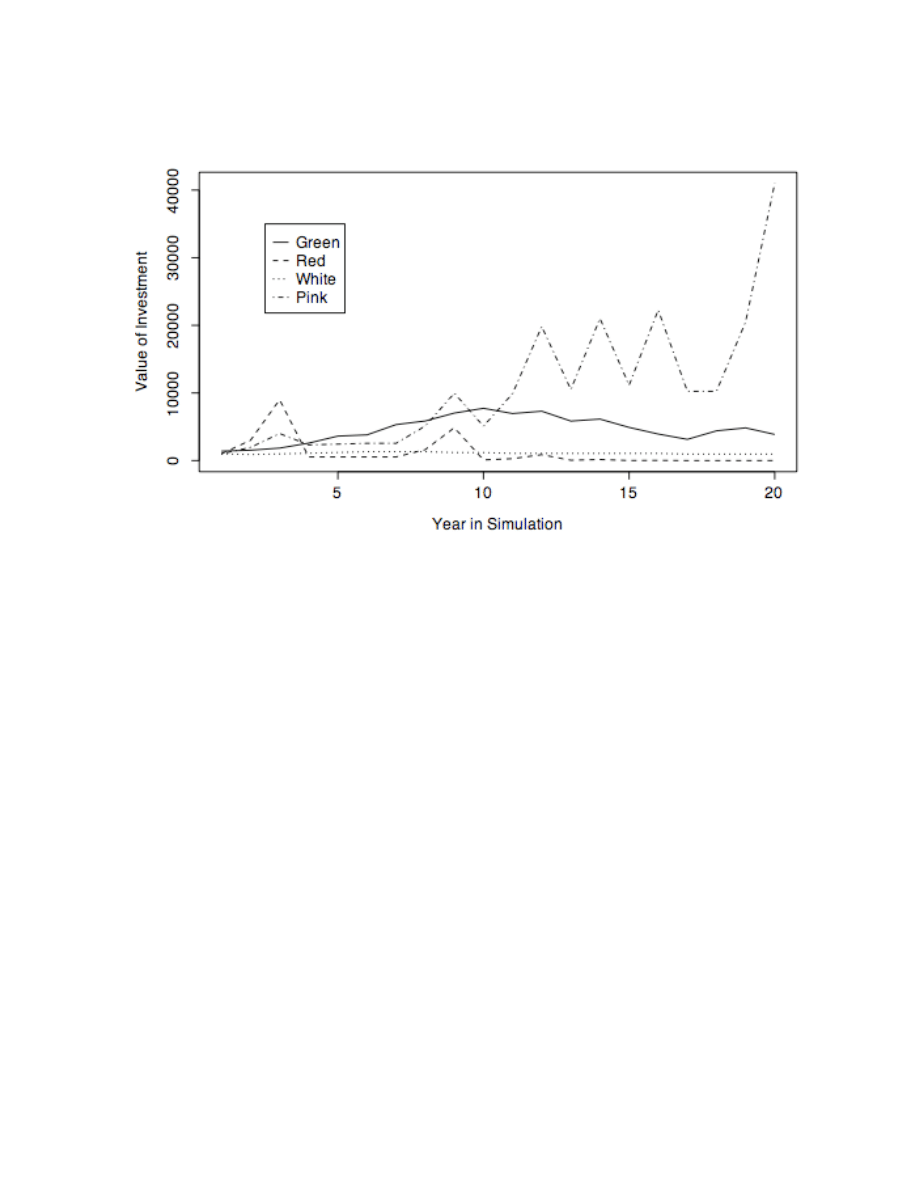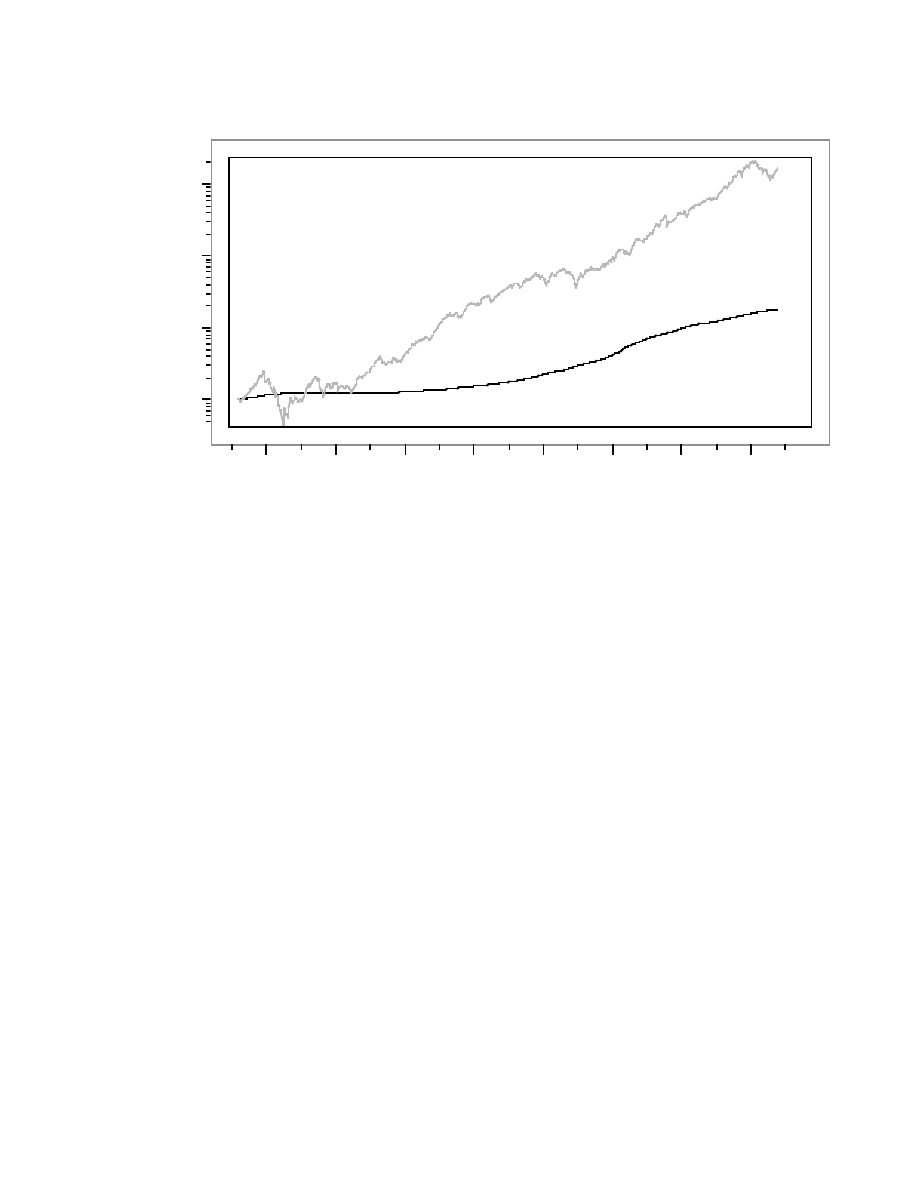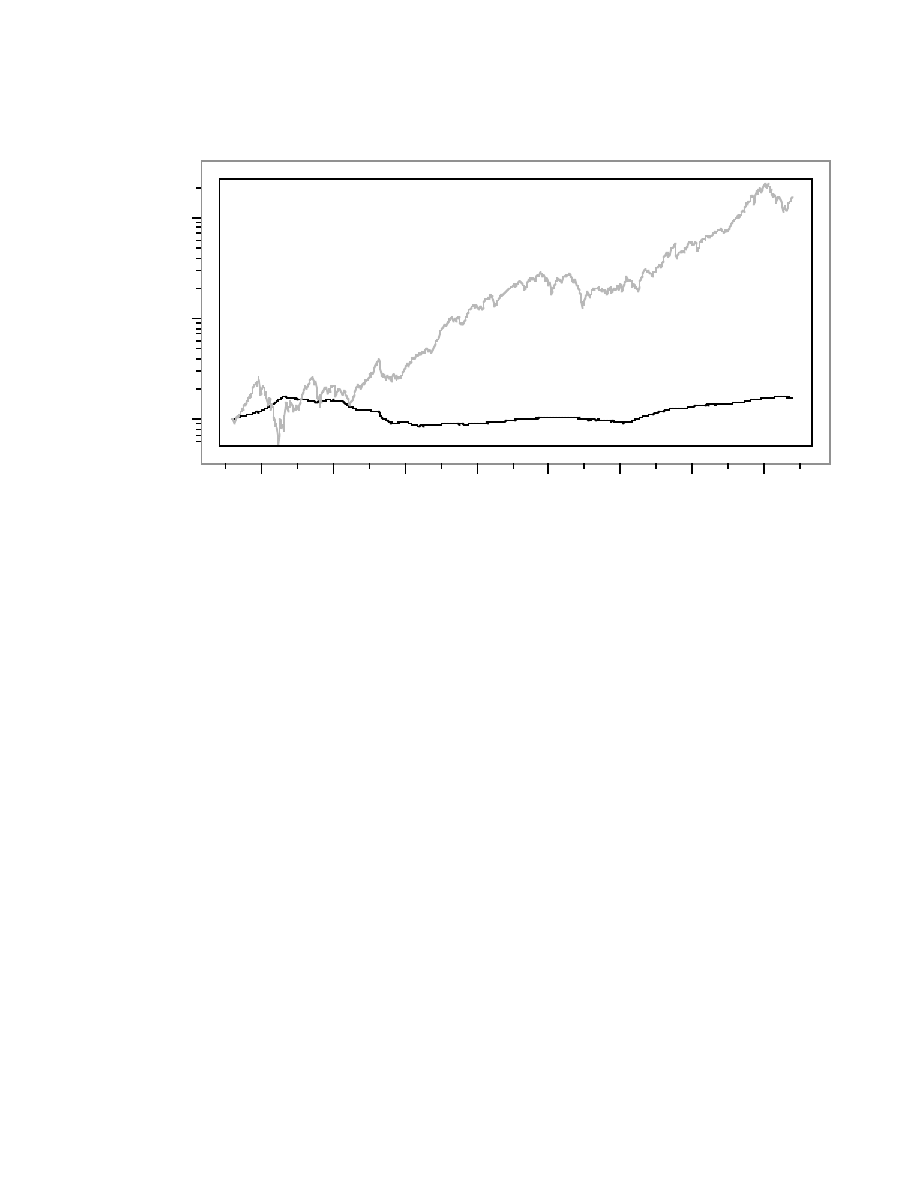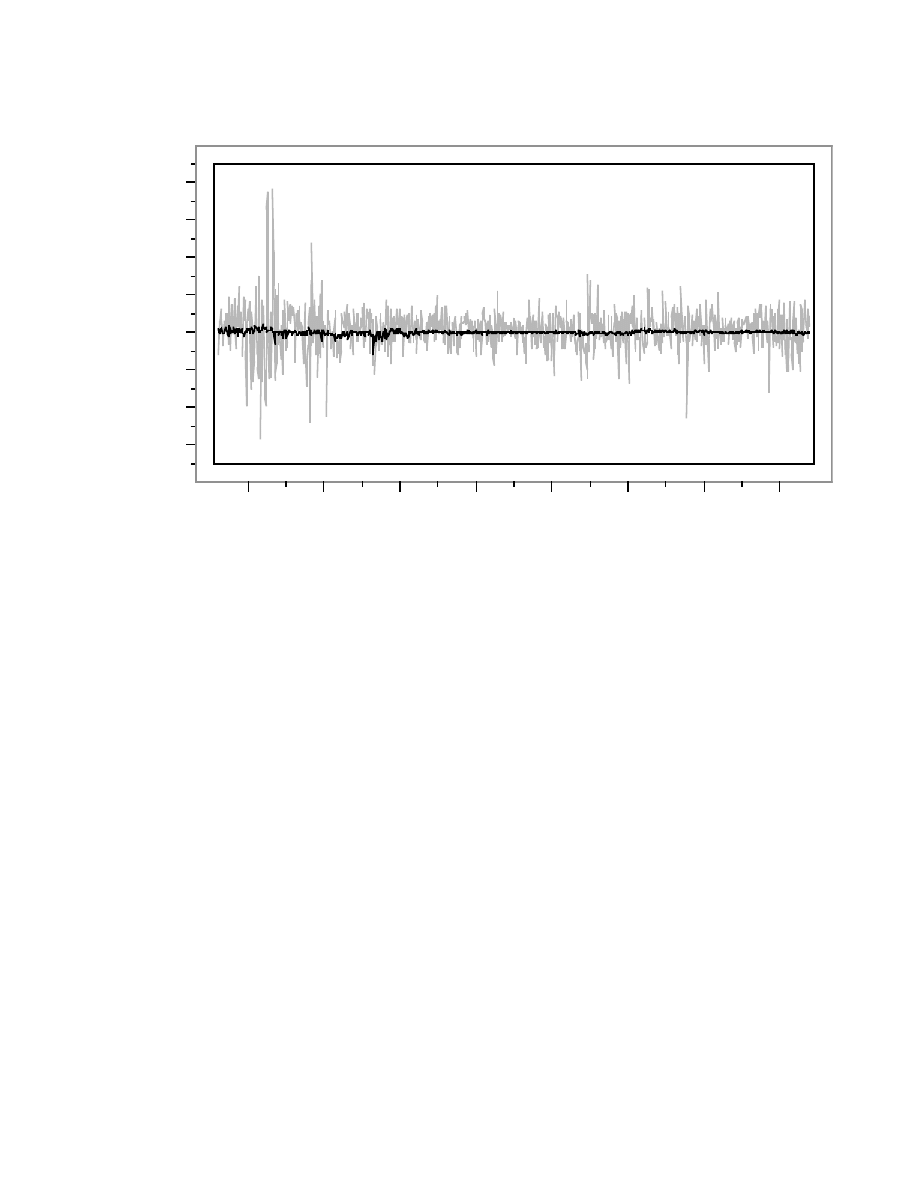
Modified 9/20/05
Being Warren Buffett: A Classroom Simulation of
Risk and Wealth when Investing in the Stock Market
Dean P. Foster & Robert A Stine
Statistics Department, The Wharton School
University of Pennsylvania
Philadelphia, PA 19104-6340
September 19, 2005
Abstract
Students who are new to Statistics and its role in modern Finance have a hard time
making the connection between variance and risk. To link these, we developed a classroom
simulation in which groups of students roll dice that simulate the success of three investments.
The simulated investments behave quite differently: one remains almost constant, another drifts
slowly upward, and the third climbs to extremes or plummets. As the simulation proceeds,
some groups have great success with this last investment – they become the “Warren Buffetts”
of the class, accumulating far greater wealth than their classmates. For most groups, however,
this last investment leads to ruin because of its volatility, the variance in its returns. The
marked difference in outcomes surprises students who discover how hard it is to separate luck
from skill. The simulation also demonstrates how portfolios, weighted combinations of
investments, reduce the variance. Students discover that a mixture of two poor investments
emerges as a surprising performer. After this experience, our students immediately associate
financial volatility with variance. This lesson also introduces students to the history of the stock
market in the US. We calibrated the returns on two simulated investments to mimic returns on
US Treasury Bills and stocks.

Being Warren Buffet
2
1. Introduction
The definition of variance as the expected squared deviation from the mean often strikes
students as capricious. When shown a histogram, our students seldom suggest measuring
spread by finding the average squared deviation from the mean – unless they have read the text
or met the definition in other courses. Those who have seen boxplots pick the interquartile
range and others suggest the average absolute deviation. Students often ask us “Why average
squared deviations from the mean?” When teaching an introductory course, we cannot appeal
to efficiency arguments that assume normality to justify variance as a “natural” measure of
scale.
When dealing with money, however, the definition of variance is just right. In Finance,
the risk of an investment is precisely the variance of its returns. Rather than link these through
definitions, we have found it more engaging and memorable to let students experience the
effects of variance first-hand in a simulation. In this experiment, students roll dice that
determine the value of several investments and reveal the role of variance. The discussion of
this simulation requires only basic properties of means and variances, with the most
sophisticated property being that the variance of a sum of independent quantities is the sum of
the variances.
We have used this dice simulation successfully for over 10 years in courses taught at
three levels. Because the exercise requires relatively little background, it can be used early in
the curriculum before normality and standard error. The simulation has become a standard
component of the introductory undergraduate course in Statistics at Wharton. Students need
only have been introduced to histograms and their connection to the mean, standard deviation,
and variance. The idea of a discrete random variable is useful (for that is what the students will
be simulating) but this is not necessary. We also regularly use this simulation in the required
MBA course. MBA students generally have a better sense of the economics of investing, but
many are nonetheless surprised to discover the rich connection between Statistics and Finance.
In more advanced courses, such as undergraduate courses in mathematical statistics or
probability, we use the dice simulation to illustrate discrete random variables. The simulation
and ensuing discussion consume a full hour and 20-minute class; it also works well divided into
2 one-hour classes.

Being Warren Buffet
3
The investments simulated by the dice in this exercise mimic actual investments. One
investment resembles a conservative money-market fund whose interest has been adjusted for
the effects of inflation. At the other extreme, a second investment matches our intuitive
definition of a risky stock. It resembles the performance of many of the high-flying tech stocks
in the late 1990s during the dot-com bubble. A third lies between these extremes and performs
like the overall stock market.
We have students simulate the value of these investments by rolling three differently
colored dice. We label the three investments Red, White, and Green because it is easy to find
dice in these colors. We have, on occasion, tried to save class time by using a computer to run
the simulation; it is easy to program the simulation in Excel, say. End-of-the-term course
evaluations have shown, however, that students who have done the experiment “by hand” more
often mention this lesson as one that was particularly effective. Students not only see the
importance of variance in Statistics, but they also discover the relevance of Statistics in the real
world. After this simulation, everyone appreciates the importance of variance when looking at
data. As our nation discusses privatizing Social Security and shifting retirement investments
into stocks, it would be useful if more citizens understood these lessons.
The following section describes the dice simulation. The third section describes the
origins of the simulated investments and explains how portfolios improve investments by
reducing variation. This section also introduces the notion of volatility drag to quantify the
effects of variation. The concluding section returns to the theme of distinguishing luck from
skill.
2. The Dice Simulation
2.1 Getting Started
Before describing the simulation, we divide the class into teams. Teams of 3 or 4 students seem
about right. One person on each team plays the role of nature (or the market) and rolls the dice.
Another keeps track of the dice and reads off their values, and a third records the outcomes.
Others can help out by retrieving the dice and checking the calculations.
Once we have divided the class into teams, we pose the following question. We’ve
found it useful to elicit a written preference from each team before starting the simulation. This

Being Warren Buffet
4
gets them talking about the simulation and avoids too many “Monday morning quarterbacks” in
the subsequent discussion. If a team has chosen an investment before starting the simulation,
the team members seem more interested in following their choice as the simulation evolves.
Question 1. Which of the three investments summarized in the following
table seems the most attractive to the members of your group?
Investment
Expected Annual
Percentage Change
SD of Annual
Percentage Change
Green
8.3%
20%
Red
71%
132%
White
0.8%
4%
Table 1. Expected value and standard deviation of the annual percentage change in the value of
three investments.
We describe the information in Table 1 using examples such as the following:
Suppose that you invest $1000 in one of these choices, say Red. Table 1
tells you that you can expect the value of your investment to be 71% larger at
the end of the first year, up to $1,710.
Similarly, if we start with $1000 in each of these, we’d expect to have $1,083 in Green and
$1,008 in White after one year. Because the expected value of a product of independent random
variables is the product of expectations, we can find the expectations for each investment over a
longer horizon given this assumption. Over 20 years, the initial investment of $1000 in Red
grows in expectation to an astonishing $1000 × (1.71)
20
= $45,700,000. By comparison, the
initial investment in Green grows to $4,927 and White creeps up to $1,173.
Students find such calculations of expected values quite reasonable, but have little
intuition for how to anticipate the importance of the standard deviation – other than to recognize
that the presence of a large standard deviation means that the results are not guaranteed. The
massive standard deviation leads some students to question the wisdom of investing in Red, but
most find it difficult to see how to trade off its large average return for the variation. The annual
return on Red is about 9 times that of Green, but its standard deviation is also 6.5 times larger.
Few students appreciate the bumpy ride promised by Red.

Being Warren Buffet
5
At this point in the discussion, many teams find the large average return of Red quite
appealing. Regardless of the level of the class, we have found the following example useful as a
means of suggesting the impact of variation on the long-run behavior of an investment.
Suppose that a graduate lands a good job that pays $100,000 per year. In the first year, the
company does well and her salary grows by 10% to $110,000. The next year is leaner, and she
has to take 10% cut in pay, reducing her salary down to $99,000. The average percentage
change in her salary is zero, but the net effect is a loss of 1% of the starting salary over the two
years. Figured at an annual rate, that’s a loss of 0.5% per year. It turns out that this simple
example is a special case of a more general property that captures how variance eventually
wipes out investments in Red.
2.2 Running the Simulation
After this introduction, we pass out three dice to each team along with a data-collection
form similar to that suggested in Figure 1. (A full-page version of this form suitable for use in
class is available at www-stat.wharton.upenn.edu/~stine.) This form organizes the results of the
simulation in a format useful in later steps. The unused last column saves space to compute the
returns on a portfolio later in the exercise. We collect these sheets at the end of the simulation
so that we can review the results in the next class. We have found that students keep better
records when we tell them in advance that we will collect these forms at the end of class.
Round
Green
Red
White
Starting value
$1000
$1000
$1000
Return
1
Value
1
Return
2
Value
2
Return
3
Figure 1. Initial rows of the data-collection form used to record the value of the three
investments simulated by rolling a red die, a white die, and a green die.
Before the class begins the simulation, we carefully explain how the dice determine the
values of the investments. Each roll of all three dice simulates a year in the market, and the

Being Warren Buffet
6
outcomes of the dice determine what happens to the money held in each investment. Table 2
shows how the outcomes of the dice affect the values of the three investments. Each cell of
Table 2 gives the gross return on every $1 invested. The gross return on an investment over
some time interval is the ratio of its final value to its initial value. For example, if the green die
rolls 1, then every dollar invested in Green falls in value to $0.80. Rather than use percentage
changes as in Table 1, we switch to gross returns for doing the calculations in the simulation.
Percentage changes are familiar, but returns are more natural for the simulation. We find it
helpful to project this table onto a screen that is visible to the class as the simulation proceeds.
Outcome
Green
Red
White
1
0.8
0.05
0.95
2
0.9
0.2
1
3
1.1
1
1
4
1.1
3
1
5
1.2
3
1
6
1.4
3
1.1
Table 2. Annual gross returns for the three investments simulated by rolling three differently
colored dice.
An example of the calculations explains the use of Table 2. Each investment in the
simulation begins with an initial value of $1000, as indicated in the first row of the data
collection form. To simulate a year in this market, each team rolls all three dice. Suppose that
on the first roll the dice show these outcomes:
(Green 2)
(Red 5)
(White 3)
The value 2 for the green die tells us to use the gross return 0.9 from the second row of Table 2
for Green; Green’s value becomes $1000 × 0.9 = $900. Said differently, the percentage change
in Green is –10%. We have experimented by showing a table of percentage changes rather
than returns, but we have found that students make fewer mistakes in calculations if given the
returns. The values of the investments after the first year are:
Green
$1000 × 0.9 = $900
Red
$1000 × 3 = $3000
White
$1000 × 1 = $1000

Being Warren Buffet
7
The outcomes of rolling all three dice a second time determine how these values grow or fall in
the second “year” of the simulation. Assume that the second roll of the dice gives
(Green 4)
(Red 2)
(White 6)
In this case, the gross return for Green from the 4
th
row of Table 2 is 1.1; Green increases by
10%. After two rounds, the three investments are worth
Green
$900 × 1.1 = $990
Red
$3000 × 0.2 = $600
White
$1000 × 1.1 = $1100
Figure 2 shows the recording sheet after the first two rolls.
Round
Green
Red
White
Starting value
$1000
$1000
$1000
Return
1
0.9
3
1
Value
1
900
3000
1000
Return
2
1.1
0.2
1.1
Value
2
990
600
1100
Return
3
Figure 2. Data table recording the outcomes of the first two rounds of the dice simulation of
three investments.
After illustrating how to use Table 2, we pose another question to the class and let the
simulation begin.
Question 2. Which of the three investments described by the multipliers in
Table 2 has the largest value after 20 years in your simulated market?
We run the simulation for 20 “years” in order to allow the long-term patterns emerge. If the
simulation runs much longer, the Red investment becomes less likely to do well. Stopping after
20 rounds leaves a good chance that some team will be doing very well with Red.
In a more advanced class that has covered discrete random variables, we describe Table
1 more precisely. Random variables are a natural way to represent the uncertainty of the value
of investments that, unlike bank accounts, can increase or decrease in value. The random
variable that is most natural in this context is the return on the investment. For example, let the

Being Warren Buffet
8
random variable R denote the gross return on Red so that the value of Red after one year is
$1000 R. If the red die rolls 2, then Table 2 gives R=0.2 so that Red falls by 80%, dropping
from $1000 down to $200. Similarly, the other columns in Table 2 define similar random
variables, say G and W, for the returns on Green and White, respectively.
We assign an exercise to have more advanced students verify that the returns in Table 2
correspond to the means and standard deviations of the percentage changes shown in Table 1.
For example, Table 1 implies that E(R) = 1.71, which can be verified from direct calculation:
!
E R
( )
=
0.05 + 0.2 + 1+ 3 + 3 + 3
6
= 1.70833
The rest of the table follows similarly.
2.3 Pink
As the class runs the simulation, we browse the room to see how the different teams are
doing and check that they are calculating the values correctly. Generally, the room gets a little
noisy, particularly if there’s a team for which Red is growing. Red triples in value half of the
time, so there’s a good chance that some team will do well with Red if the simulation is run 20
rounds. Direct calculation shows that the probability that Red ending with value $10,000 or
more is about 20%, and the chance for becoming a millionaire with Red is a bit larger than 5%.
After letting the class run the simulation for 20 rounds, we interrupt the chatter and pose
another task. We ask the students to consider a hybrid investment that mixes the previous
results for Red and White. We call this investment Pink. This task does not require more
rolling of the dice. All of the information needed for this part of the experiment is already
recorded on the data collection form.
To compute the value of Pink, we instruct the students to use the previously recorded
outcomes of the red and white dice. It is again easiest to describe how to find the value of Pink
with an example. Pink also begins the simulation with $1000, evenly split between Red and
White. As a result, the return for Pink is the average of the returns previously obtained for Red
and White. For example, using the same outcomes as in the previous illustration (Red=5 for a
return of 3 and White=3 for a return of 1), the value of the Pink becomes
$1,000 ×
!
3 + 1
2
= $2,000

Being Warren Buffet
9
Compounded in the second round (in which Red=2 with return 0.2 and White=6 with return
1.1), the value of Pink falls to
$2,000 ×
!
0.2 + 1.1
2
= $1,300
Figure 3 shows the data recording form after adding these calculations for Pink in the last
column. It is essential that students average the returns, not the values, for Red and White.
Round
Green
Red
White
Pink
Starting value
$1000
$1000
$1000
$1000
Return
1
0.9
3
1
2
Value
1
900
3000
1000
2000
Return
2
1.1
0.2
1.1
0.65
Value
2
990
600
1100
1300
Return
3
Figure 3. Data recording form with the values for Pink added to the calculations.
Before turning the teams loose to compute Pink, we pose a third group of questions to
make them think before calculating. Because Pink mixes the returns of Red and White, most
students anticipate it to mix bad with boring and fall in value.
Question 3. Before you compute your outcomes, discuss Pink with your
team. How you expect Pink to turn out? Do you think it will be better or
worse than the others?
We have found it useful to circulate through the room as the teams figure out the results
for Pink. Often, as they do the calculations, teams suspect that they have done something
wrong because Pink does so well! A common mistake is to shortcut the work by averaging the
final values for Red and White. This error gives a very different answer than obtained by
averaging the returns.

Being Warren Buffet
10
2.4 Collecting the results
Once the teams have finished calculating the values of Pink, we query them in class for
their results. To maintain flow of the discussion, we find it easiest to track the outcomes for the
investments on a transparency that we augment as teams announce results. Figure 4 shows the
results from a typical run of the dice simulation. Pink generally “wins” for most teams. Green
shows steady growth and is usually the best of the original alternatives. White seldom moves
far from the initial $1,000 stake. For most, Red bounces around and then becomes near
worthless, falling to pennies in value.
Figure 4 about here
The dice simulation surprises most students, even more experienced MBAs. Perhaps the
biggest surprise happens when a team announces a huge value for Red. As we poll the class,
most teams announce small values in Red, often less than $1. It comes as quite a shock when a
team announces that their investment in Red is worth more than $10,000,000. With a bit of
fanfare, we proclaim this team to be the “Warren Buffetts” of the class. Business students
generally know the name by reputation.
Warren Buffett is well-known among investors for his down-to-earth approach to
investing. Often ignoring popular trends, Buffett built his company, Berkshire Hathaway, into a
$133 billion holding company by purchasing the stocks of companies that made products he
liked and understood. His strategy has been very successful. In 2005, Forbes Magazine
estimated Buffett’s net worth at $44 billion, second only to that of Bill Gates in its list of the
most wealthy people in the world.
Pink presents the students with their second surprise. The results in Figure 4 are typical.
Pink is more volatile than Green, but closes with a larger value. Across the class – with the
exception of the Warren Buffetts – Pink usually finishes with the highest value. Though Pink
mixes two investments that are individually poor choices, this simple mix of Red and White
performs very well. That frequently seems impossible to the class: How can an average of two
poor investments become so valuable? Their surprise brings curiosity and provides an incentive
for trying to understand the role of the variance.

Being Warren Buffet
11
3. Discussing the Simulation
3.1 Why these multipliers?
We open our discussion of the dice game by linking the dice to real investments. Green,
which does the best for most teams until they discover Pink, performs like the US stock market
when adjusted for inflation. White represents the inflation-adjusted performance of US Treasury
Bills, the canonical “risk-free” investment. We made up Red. We don’t know of any investment
that performs like Red. If you know of one, please tell us so we can make Pink!
We find our classes eager to see the underlying financial data. To save time, one could
alternatively provide a handout summarizing these background facts. The timeplot in Figure 5
summarizes the history of stocks and Treasury Bills in the US, monthly from 1926 through the
end of 2003. This plot tracks the cumulative value of one dollar invested in January 1926 in a
value-weighted portfolio of the US stock market and 30-day Treasury Bills. (A value-weighted
portfolio, such as the S&P 500, buys stock in proportion to their capitalized value. Alternatives
such as the Dow-Jones Index simply buy one share of each.) The y-axis in the timeplot uses a
log scale. When plotted on a log scale, geometric growth appears as a straight line.
Figure 5 about here
This plot is a little misleading because it ignores inflation. Although inflation has
recently been low, it has exceeded 15% annually in the past. (For students who are unfamiliar
with the impact of inflation, we find it helpful to show a timeplot of this series as well.) To
adjust for inflation, Figure 6 shows the cumulative values after subtracting the rate of inflation
from the growth of $1 investments in the stock market and Treasury Bills. To measure
inflation, we used annual changes in the Consumer Price Index in the US. Once adjusted for
inflation, investments in Treasury Bills declined for several long periods, and the initial $1
invested in Treasury Bills in 1926 closes at $1.66 at the end of 2003. The $1 invested in the
stock market reaches $161, even allowing for the Great Depression and the bursting of the dot-
com bubble.
Figure 6 about here
Returns are the key random variables in the dice simulation. Figure 7 shows monthly
gross returns for stocks and Treasury Bills (after subtracting inflation) on the scale 0.7 to 1.4 (–
30% to 140%). The variation of the return on Treasury Bills is much smaller than the variation

Being Warren Buffet
12
in returns on stocks. Returns on the stock market use the full range of the plot; those of
Treasury Bills never venture far from 1. We prefer to plot monthly returns rather than annual
returns because monthly returns reveal features that are otherwise lost on the more coarse time
scale. At the left of Figure 7, for example, is the Great Depression starting in the late 1920s and
running through the 1930s. Returns on the market were incredibly volatile during that period.
In 1933, the market dropped almost 30% in one month. Less well known is that about a year
later, the market increased by about 40% in each of two months. Following WW II, gross
returns on stocks became rather stable – at least in comparison to the volatility during the
Depression. One can also see other important events, such as the fall of the stock market in
October 1987.
Figure 7 about here

Being Warren Buffet
13
Stocks
T-Bills
Mean
1.0877 1.0073
Std Dev 0.2050 0.0404
Variance 0.0420 0.0016
N
78
78
Table 3. Means, standard deviations and variances of annual, inflation-adjusted returns on US
stocks and Treasury Bills.
Table 3 gives means, standard deviations, and variances of the annual historical returns
on stocks and Treasury Bills. The annual return on the US stock market above inflation from
1926 through 2003 averaged 1.0877, slightly more than 8% with standard deviation 0.205,
about 20%. Returns on Treasury Bills have been essentially flat, just keeping pace with
inflation. The average return above inflation for Treasury Bills has been 1.0073, about 2/3 of
one percent. The annual standard deviation is 5 times smaller than that of the stock market.
When compared to the properties of the investments simulated by the dice, we see that
Green mimics the market and White, Treasury Bills. The expected return on Green (1.083,
shown in Table 1 as 8.3%) is very close to the annual return on the market with comparable
standard deviation. Similarly both the mean of White (1.008) and its standard deviation (0.04)
are close to those of annual returns on Treasury Bills.
3.2 The Role of Variance: Volatility Drag
Pink surprises the class. Before getting into details, it is essential that students
understand that Pink is not a simple average of Red and White. The returns on Pink average
those on Red and White, but one does not get this performance by starting with $500 in Red and
$500 in White and leaving it there. Pink requires that the portfolio be rebalanced at the end of
each period so that half of the value is kept in Red and half in White. Returning to the
illustrative calculations, at the end of the first round the initial $500 invested in Red grows to
$1500 and the $500 invested in White holds its value. Before the next round, the portfolio
needs to be put back into 50-50 balance; that is, we need to move $500 from Red into White, so
that each has $1000 at the start of the next round. This “protects” some of the earnings
produced by Red in the prior round from subsequent volatility. When the second roll wipes out

Being Warren Buffet
14
80% of the value of Red, it only reduces the $1000 left in Red down to $200. The other $500
produced by Red in the first round remains safely in White.
We next like to show that it is possible to anticipate the success of Pink. All we need are
its mean and its variance. We can get these moments from those for Red and White given in
Table 1 or, to more accuracy, Table 4. (We will describe the last column of Table 4 shortly.)
Because the return on Pink averages those on Red and White, students willingly accept that the
mean return on Pink is (1.7083 + 1.0083)/2 = 1.3583. Finding the variance is harder and
requires that students know two rules for manipulating variances:
(a) Constants factor out with squares, Var (c X) = c
2
Var(X), and
(b) For independent random variables X and Y, variances of sums are sums of
variances, Var(X+Y) = Var(X) + Var(Y).
Because we simulate the returns using separate dice, it should be clear that the returns on Red
and White are independent. (Along with the invention of Red, independence of the returns in
the dice simulation is a simplifying assumption that differs from the real world. Returns on real
investments are usually correlated, complicating the analysis of a portfolio.) Using (a) and (b),
the variance of returns on Pink are easily found to be
!
Var(Pink) = Var
R + W
2
"
#
$
%
&
'
= Var
R
2
"
#
$
%
&
' + Var
W
2
"
#
$
%
&
'
=
Var(R) + Var(W )
4
=
1.7554 + 0.0020
4
= 0.4393
Pink gives up ½ of the return on Red in return for reducing the variance by ¼.
Investment
Mean
Return
Variance of
Return
Volatility
Adjusted Return
Green
1.0833
0.0381
1.0643
Red
1.7083
1.7554
0.8307
White
1.0083
0.0020
1.0073
Pink
1.3583
0.4393
1.1387
Table 4. Mean, variance and volatility adjusted return of the four simulated investments in the
dice game.

Being Warren Buffet
15
At this point, the class still lacks a way of anticipating the success of Pink and the failure
of Red. The answer lies in finding an expression that combines the mean with the variance to
shows how variation eats away at the value of an investment. Because it reflects how variation
(or volatility) diminishes the value of an investment, we refer to this adjusted return as the
volatility adjusted return. This is also known in Finance as the long-run return on an
investment. The formula for computing the volatility adjusted return is simple:
Volatility-adjusted return = Long-Run Return
= Expected Return – (Variance of Return)/2
The penalty for variation, ½ of the variance, is sometimes called the volatility drag.
The last column of Table 4 shows the volatility adjusted return for Green, Red, White
and Pink. Not surprisingly, Pink is most attractive, with more than twice the volatility adjusted
return of the stock market. On the other hand, the volatility adjusted return for Red is less than
1, showing that it ultimately loses value. Even though Red loses value for most teams, mixing it
with White reduces the variance and produces a huge win. (As a little follow-up exercise, you
might want to have students consider the following: What is the optimal mix of Red and White?
That is, what proportions of Red and White produce the highest volatility-adjusted return?)
Depending on the level of the class, we spend more or less time describing the origins of
the formula for the volatility adjusted return. After all, the units of the mean and variance do not
match so it seems odd to subtract one from the other. In an introductory class that has covered
discrete random variables, we can get this formula for the volatility drag from our simple
example of variation in changes in salary. Think of the changes in salary as a random variable,
with half of the probability on a return of 1.1 (up 10%) and the other half on 0.9 (down 10%).
The expected value of this random variable is 1, and its variance is 0.1
2
= 0.01. Now look back
at the introductory example. The salary dropped by 0.5% per year, effectively returning 0.995,
which is precisely 1 – ½(0.01). When corrected for volatility, each year of employment reduces
the salary by half of the variance of the percentage changes even though the expected return is
1.
For an advanced undergraduate class in mathematical statistics or probability, we take
this much further. Although we seldom use this material in an introductory class, we have
found it useful to explain volatility drag to more interested students who are surprised to see the
importance of various approximations that they have seen in better calculus courses. This

Being Warren Buffet
16
explanation amounts to developing an approximation to the geometric mean using the first two
moments of the underlying random variable, here the returns. (An accessible summary of this
and related approximations, as well as their use in evaluating investments, appears in Young
and Trent 1969). Label the initial value of an investment as W
0
; W
0
= $1000 in the dice game.
Label the return on an investment, say Red, during year t as R
t
. The value at the end of the first
year is W
1
= W
0
R
1
. By the end of year T the value is
W
T
= W
0
R
1
R
2
··· R
T
Taking logs converts this product to a sum that holds an average:
!
logW
T
= logW
0
+
log R
t
t=1
T
"
= logW
0
+ T #
log R
t
t=1
T
"
T
$ logW
0
+ T # E log R
t
The last approximation only applies for large T by the weak law of large numbers. The
expected value E log R
t
is called the expected log return in Finance, yet another name for the
long-run growth rate. To arrive at the volatility drag, we use the familiar approximation
!
log(1+ x) " x #
x
2
2
and write R
t
= 1 + r
t
. (Some also call r
t
the return, adding to the confusion between returns and
percentage changes.) If we denote E r
t
= µ
r
and Var R
t
= σ
2
r
, then the approximation to the log
allows us write
!
E log R
t
= E log 1+ r
t
(
)
" E r
t
#
r
t
2
2
$
%
&
'
(
)
"
µ
r
#
*
r
2
2
Because r
t
is small in practice, Var(r
t
) = E r
t
2
– (E r
t
)
2
≈ E r
t
2
. Thus the value of this investment
after T periods is approximately

Being Warren Buffet
17
!
W
T
" W
0
e
µ
r
#
$
r
2
/ 2
(
)
T
" W
0
1+
µ
r
#
$
r
2
/2
(
)
T
" W
0
E R
t
# Var(R
t
) /2
(
)
T
It is useful to compare this expression to the expectation itself, namely E W
T
= W
0
(E R
t
)
T
.
Alternatively, one can avoid these approximations by making the strong assumption that returns
follow a lognormal distribution. That argument, however, requires an assumption about the
distribution of the returns that is hard to verify in practice. For students who have studied
economics and utility theory, it may also be useful to observe that maximizing the geometric
mean is not universally optimal (Samuelson 1971). Finally, in a very advanced class, one can
use this discussion to motivate the importance of the Shannon-Brieman-MacMillan theorem (for
example, see Chapter 15, Cover and Thomas 1991). But we’ll not do that here!
4. Conclusion
What about those Warren Buffetts?
We developed this simulation to show off the importance of the variance in assessing the
long-term value of investments. Pink illustrates how one can gain positive long-run returns by
designing a portfolio that sacrifices expected returns to reduce the variance.
Having used this simulation in undergraduate and MBA classes for several years at
Wharton, we have come to appreciate the important message conveyed by the Warren Buffetts
of the class. These are the few teams that, unlike most others, end the simulation with Red
reaching into the millions. It comes as quite a surprise to the rest of the class to discover, as we
collect the final values from the teams, that some of their classmates have had huge success
with Red. The differences are not slight either. For a team whose $1000 in Red has shrunk to
pennies, it seems impossible that another team’s investment in Red is worth more than
$10,000,000 at the end of the simulation. After all, they all used the same rules to find the value
of Red. Indeed, we formerly ran the simulation longer, hoping that volatility would wipe out
these lucky winners. We have, however, come to realize that these surprises allow us to present
the students with an important question.
What makes them believe that the real Warren Buffett was not just lucky? After all,
with millions of investors seeking profits from the stock market, could it be that Warren Buffett

Being Warren Buffet
18
simply “got lucky.” There is usually considerable resistance from fans of the “Oracle of
Omaha”, but even they have to concede how difficult it is to separate a knowledgeable strategy
from a lucky strategy. In the dice simulation, all of the teams use the same “strategy” for Red
and rolled the dice themselves; nothing is hidden in a mysterious random number generator.
They all start with $1000 in Red, but only a lucky few end the simulation appearing a lot
smarter than the others. In the dice game, they can all see that it was simply luck that produced
the Warren Buffetts.
We are careful not to say that Warren Buffett became successful by sheer luck. After
all, much of his reputation was earned by conservative investments in established companies,
such as Coca-Cola, that others had overlooked. We simply point out the difficulty in separating
skill from luck, a problem that bedevils investors in hedge funds and requires methods outside
the scope of this paper that we plan to describe elsewhere.
References
Cover, T. M. and J. A. Thomas (1991). Elements of Information Theory, Wiley, New York.
Samuelson, P. A. (1971). The fallacy of maximizing the geometric mean in long sequences of
investing or gambling. Proceedings of the National Academy of Sciences, 68, 2493-2496.
Young, W. E. and R. H. Trent (1969). Geometric mean approximations of individual security and
portfolio performance. The Journal of Financial and Quantitative Analysis, 4, 179-199.

Being Warren Buffet
19
Figure 4. Timeplots of the values of four simulated investments in the dice game. The outcomes
depict the typical results of the simulation.

Being Warren Buffet
20
1
0.5
10
5
2
100
50
30
1000
500
200
2000
C
u
m
u
la
ti
ve
V
al
u
e
1930
1940
1950
1960
1970
1980
1990
2000
Year
Figure 5. Cumulative value of investing $1 in 1926 in the stock market (gray) and in 30-day
Treasury Bills.

Being Warren Buffet
21
1
0.6
10
6
4
2
100
60
40
20
200
C
u
m
u
la
ti
ve
V
al
u
e
1930
1940
1950
1960
1970
1980
1990
2000
Year
Figure 6. Cumulative value of investing $1 in 1926 in the stock market (gray) and in 30-day
Treasury Bills after adjusting for inflation by subtracting the rate of change in the Consumer
Price Index.

Being Warren Buffet
22
0.7
0.8
0.9
1
1.1
1.2
1.3
1.4
M
o
n
th
ly
R
et
u
rn
1930
1940
1950
1960
1970
1980
1990
2000
Year
Figure 7. Timeplot of inflation-adjusted monthly returns for stocks (gray) and Treasury Bills.
Wyszukiwarka
Podobne podstrony:
(Trading) Paul Counsel Towards An Understanding Of The Psychology Of Risk And Succes
Gender and Racial Ethnic Differences in the Affirmative Action Attitudes of U S College(1)
Issue of Gun Control and Violence As Seen in the U S and
20 Seasonal differentation of maximum and minimum air temperature in Cracow and Prague in the period
Of Mice and Man Emotional Reaction to the Novel
Hamao And Hasbrouck Securities Trading In The Absence Of Dealers Trades, And Quotes On The Tokyo St
Co existence of GM and non GM arable crops the non GM and organic context in the EU1
Creation of Financial Instruments for Financing Investments in Culture Heritage and Cultural and Cre
The Application of Domestication and Foreignization Translation Strategies in English Persian Transl
Taylor, Functional Uses of Reading and Shared Literacy Activities in Icelandic Homes
Barwiński, Marek Polish Interstate Relations with Ukraine, Belarus and Lithuania After 1990 in the
Warren Buffett On The Stock Market
An Assessment of the Efficacy and Safety of CROSS Technique with 100% TCA in the Management of Ice P
Risk of Cancer by ATM Missense Mutations in the General Population
Learning to Detect and Classify Malicious Executables in the Wild
[Форекс] The Cost of Technical Trading Rules in the Forex Market
Nadelhoffer; On The Importance of Saying Only What You Believe in the Socratic Dialogues
2000 Influence of Fiber Fermentability on Nutrient Digestion in the Dog
CRASHES AND CRISES IN THE FINANCIAL MARKETS, ekonomia III, stacjonarne
więcej podobnych podstron